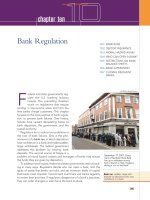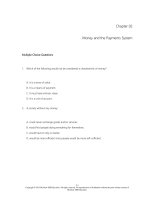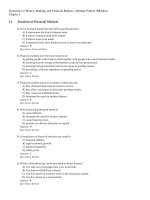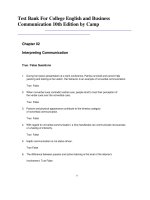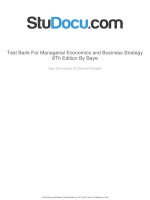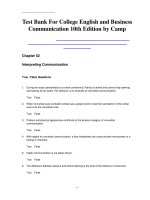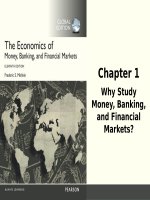Test bank for money banking and financial markets 3rd edition by cecchetti
Bạn đang xem bản rút gọn của tài liệu. Xem và tải ngay bản đầy đủ của tài liệu tại đây (345.37 KB, 68 trang )
Test bank for Money Banking and Financial
Markets 3rd Edition by Cecchetti
Link full download: />Chapter 02
Money and the Payments System
Multiple Choice Questions
1. Which of the following would not be considered a characteristic of money?
A. It is a store of value
B. It is a means of payment
C. It must have intrinsic value
D. It is a unit of account
2. A society without any money:
A. Could never exchange goods and/or services
B. Would find people doing everything for themselves
C. Would have to rely strictly on barter
D. Would be more efficient since people would be more self-sufficient
3. The use of money makes us more efficient because:
A. We spend more time trading and more time producing
B. People can specialize in what they do well
C. With money we borrow less
D. Money increases in value over time
2-1
4. The unit of account characteristic of money:
A. Makes it difficult to compare the relative prices of goods and services
B. Refers to how we use money to transfer purchasing power over time
C. Means all prices are expressed in terms of money
D. Means that money finalizes payments
5. Without the use of money, workers in an economy:
A. Would become more specialized
B. Would have to spend a lot less time trading
C. Would probably specialize less
D. Would be far more productive
2-2
6. As an economy produces more different types of goods:
A. It is more difficult to quote prices if the economy does not use money
B. The number of relative prices decreases
C. Money becomes less useful as a unit of account
D. Money becomes less useful as a standard of value
7. The store of value characteristic of money refers to the fact that:
A. People save most of their money
B. Sellers are less likely to accept perishable goods in exchange for goods they sell
C. Money is not valuable unless it is stored
D. Money is the only way people have to store value
8. Which best describes money as a means of payment?
A. Money provides an immediate double coincidence of wants
B. Money makes sure a double coincidence of wants never occurs
C. Money requires at least two transactions to obtain the double coincidence of wants
D. To obtain a double coincidence of wants without money is impossible
9. Compare two economies: a barter economy versus an economy that uses money. In order to
exchange goods and services:
A. A double coincidence of wants is necessary in the barter economy
B. A double coincidence of wants is more likely to occur in the barter economy
C. Transactions are likely to be smoother in the barter economy because goods and services
are exchanged directly
D. The money economy requires that sellers have more information about buyers' wants
10. In a barter system:
A. People have to specialize in order to have goods to trade
B. People cannot specialize because they never know what goods will be desired
C. People are less likely to specialize as extensively as they would in a monetary economy
D. People must be self sufficient
2-3
11. How many prices would a trader of a particular good need to know in a barter economy
with 5 goods?
A. 5
B. 10
C. 20
D. 50
12. How many prices would a trader of a particular good need to know in a barter economy
with 20 goods?
A. 190
B. 100
C. 20
D. 40
13. In a barter economy with "n'' number of goods there will always be:
A. Exactly "n'' relative prices
B. Fewer than "n'' relative prices
C. More than "n'' relative prices
D. "n''/2 relative prices
14. The high transaction costs associated with a barter system refers to:
A. The fact that, often times, these exchanges are taxed by governments
B. The risk associated with having to carry an inventory of goods to trade
C. The high cost associated with finding someone with whom to exchange
D. The cost of drawing up complete contracts
15. Suppose that in a barter economy Tom bakes bread and Hans produces chocolates. Tom
wants chocolates but Hans doesn't like bread, so Hans is unwilling to trade with Tom. Tom's
problem is an example of which problem associated with a barter system?
A. Too much specialization
B. Not enough prices
C. The law of diminishing returns
D. The double coincidence of wants problem
2-4
16. Specialization usually increases the output of a country; however effective specialization
requires:
A. Everyone in the country producing the same thing
B. That workers have very similar skills
C. An effective low-cost means to exchange goods and services
D. A large stock of capital
17. Which of the following is not an example of bartering?
A. Sue trading candles with Tom for his bread
B. Mary paying for her new shoes with her credit card
C. John cutting his neighbor's grass in return for his neighbor washing John's car
D. Mrs. Smith treating the neighbor children to pizza after they helped clean up her yard
18. Money eliminates the need for:
A. A search for a double coincidence of wants
B. Government regulation
C. Specialization of labor
D. Financial Intermediaries
19. Money as a means of payments refers only to:
A. Actual currency
B. Coins and currency
C. Coins, currency and credit cards
D. Anything that is generally accepted as payment for goods and services
20. While money is an asset not all assets are money because:
A. Only money stores value
B. Money works as a means of payment
C. Only money is a good asset to hold during times of inflation
D. Money must be legal tender
2-5
21. An advantage that money has over other assets is that it:
A. Increases in value over time
B. Has lower transaction costs to use as a means of payment than other assets
C. Provides a higher return to the owner
D. Is a safer asset to hold during times of inflation
22. An individual who stores wealth in art rather than money will find that he/she:
A. Suffers larger real losses during periods of high inflation
B. Has far more liquidity than most savers
C. Will incur higher transaction costs when he/she ultimately makes purchases
D. Will have to resort to barter exchanging the art for desired goods
23. Which of the following statements is most correct?
A. Money is wealth but not all wealth is money
B. Money is a means of payment but is not part of wealth
C. In order to be considered part of a person's wealth, an asset must have a positive return
D. Wealth is a store of value but is not a means of payment
24. Which of the following statement is incorrect?
A. Money is wealth but not all wealth is money
B. Money is a means of payment but is not part of wealth
C. An asset doesn't have to be a means of payment to be a part of a person's wealth
D. All items considered wealth can eventually be converted to a means of payment
25. Which of the following statements is not true?
A. For most of history gold has been the most common commodity money
B. The most common form of money in the U.S. is not a commodity money
C. Gold is an example of a fiat money
D. U.S. currency is legal tender
2-6
26. Gold would be a superior commodity money compared to wheat because:
A. Wheat has a high value relative to weight, which gold does not
B. It is easier to divide wheat into small units
C. Wheat has more practical uses than gold
D. Wheat is perishable
27. The fact that U.S. currency is legal tender means:
A. U.S. currency is good anywhere in the world
B. The only money the government will accept for settlement of debts is U.S. currency
C. Private businesses in the U.S. and the U.S. government must accept currency for payment
D. It cannot be backed by gold or other metals
28. In comparing money to a U.S. Treasury bond held by an individual, we can say:
A. The Treasury bond is an asset but money is not
B. Money is an asset but the U.S. bond is a liability of the individual
C. Both are stores of value
D. Money is a store of value but the bond is not
29. In comparing money to a U.S. Treasury bond held by an individual, we can say:
A. Both are legal tender
B. Both are units of account
C. Only the bond is legal tender since it is an obligation of the U.S. Government
D. Both are stores of value
30. In comparing money to a share of Microsoft stock held by an individual, we can say:
A. The share of stock is an asset, but money is a liability
B. Only the money is a means of payment, but both are stores of value
C. Only the money is a means of payment, but both are units of account
D. Both the Microsoft stock and the money are liabilities
2-7
31. Comparing checks and currency, we can say:
A. Both are money but only currency is legal tender
B. Only checks are both money and legal tender
C. A check isn't money but currency is
D. Both are money and legal tender
32. When the Continental Congress issued currency to finance the Revolutionary War, the
Continental Congress:
A. Issued too many "continentals," making the currency worthless
B. Tied the value of the "continental" to gold
C. Tied the value of the "continental" to gold to French "assignats."
D. Made "continentals" legal tender
33. During the Civil War, the North issued currency, known as "greenbacks". Which of the
following is true of "greenbacks"?
A. Greenbacks are still legal tender in the U.S
B. Greenbacks were tied to the value of gold and silver
C. The South used "greenbacks" to pay for salaries and supplies
D. Greenbacks are a historical example of commodity money
34. Most of the non-cash retail payments made each year in the United States are made by:
A. Check
B. Credit card
C. Debit card
D. Electronic funds transfers
35. All of the following are true about electronic funds transfers except:
A. Sometimes involve the Federal Reserve sending electronic images of checks to banks
B. Occur when banks or individuals deposit/withdraw from one bank account to another
electronically
C. Include automated clearinghouse transactions (ACH)
D. Include credit card payments made online
2-8
36. Carlos pays his cable bill using his bank's internet banking web site to withdraw funds
from his checking account. This transaction is a(n):
A. Automated clearinghouse transaction (ACH)
B. Digitized-check transaction
C. E-money transaction
D. Fedwire transaction
37. As a result of "Check 21—The Check Clearing for the 21st Century Act":
A. Banks no longer have to ship paper checks to complete the process of check clearing
B. People can write checks and plan on having a couple of days to make a deposit to cover the
check amount
C. Canceled checks can no longer be used as proof of payment
D. The Federal Reserve is no longer involved in the check-clearing process
38. The value of fiat money:
A. Comes from its intrinsic value
B. Is worth more as a commodity than its value as money
C. Comes from government decree
D. Means that it is more desirable than currency
39. Which of the following could not be used as commodity money?
A. Gold coins
B. Cigarettes
C. U.S. Currency
D. Silk
40. U.S. currency is
A. A commodity money
B. Fiat money
C. Tied to the value of gold at a fixed rate
D. The only store of value
2-9
41. Checks are:
A. Not a means of payment
B. Not money
C. Not a promise of any kind
D. Not acceptable by the U.S. Government for payment of taxes
42. One major difference between a debit card and a credit card is:
A. Only the debit card helps you to build a credit history
B. The debit card has lower minimum monthly payments
C. You do not need to actually have the funds in your account when you use a debit card
D. Debit cards have no late fees
43. One major difference between a debit and credit card is:
A. You can build a credit history with the credit card but not with the debit card
B. You have to pay interest on your purchases if you use a credit card
C. Credit cards are money and the debit card is not
D. Debit cards charge late fees
44. To say an asset is liquid implies that:
A. We are focusing on a category of assets that are in a physically liquid form, like oil
B. We are considering assets that may be readily converted into a means of payment
C. We are considering any asset that can be sold
D. We are only considering U.S. currency
45. One advantage of using checks over a debit card is:
A. Checks can be replaced if lost or stolen, a debit card cannot
B. The bank is responsible if someone steals your checks and uses them; this isn't the case
with debit cards
C. A cancelled paper check is the only generally accepted proof of payment
D. The person has "float," meaning time between writing the check and depositing funds to
cover it
2-10
46. Checks and currency function similarly, however:
A. Currency is a more effective means of payment
B. Carrying currency entails greater risk, because it cannot be replaced if lost or stolen
C. Currency is a better store of value than checking deposits
D. Checks are not included in measures of money, whereas currency is
47. Money aggregates can best be defined as a set of measures of the amount of:
A. Money that exists at a particular point in time
B. Money the Federal Reserve has on deposit as reserves
C. Money available to the economy over a year
D. U.S. currency the Bureau of Printing and Engraving has produced
48. The money aggregate M1 includes each of the following, except:
A. Currency in the hands of the public
B. Travelers checks that have been issued
C. Currency in the vaults of commercial banks
D. Demand deposits at commercial banks
49. The amount of currency in the hands of the public is approximately what percentage of
M1?
A. 50%
B. 25%
C. 30%
D. 90%
50. The money aggregate M2 includes:
A. Large denomination time deposits
B. Stock and bond mutual fund shares
C. Savings deposits but not money market deposit accounts
D. M1
2-11
51. The most commonly quoted monetary aggregate is:
A. Money-market mutual fund shares
B. M1 since it is the most liquid
C. Public currency
D. M2 since its movement is most closely related to interest rates and economic growth
52. An automobile is an asset, but it is not liquid because:
A. The transactions costs for the used automobile market are high
B. The owner may still be making payments on the loan
C. The automobile may not be in good repair
D. The automobile cannot be sold without a loss in value
53. Which of the following lists correctly orders assets from most liquid to least liquid?
A. Stocks¼house¼paper currency¼savings deposits
B. Stocks¼paper currency¼house¼savings deposits
C. Savings deposits¼paper currency¼house¼stocks
D. Paper currency¼ savings deposits¼stocks¼house
54. Which of the following assets is the most liquid?
A. Art
B. Demand deposits
C. Houses
D. Stocks
55. Considering the roughly $880 billion in U.S. currency held by the public:
A. Over 90% of the amount is held in the form of $1 bills
B. Nearly 80% is held in the form of $100 bills
C. Over half of the currency held in the form of $20 bills
D. The Federal Reserve distributes the amount equally across all denominations of bills
2-12
56. Ava buys a $2,000 computer using a paper check. At which step does $2,000 get recorded
in M1?
A. When Ava hands the $2,000 check to the computer merchant
B. Once the $2000 is credited to the merchant bank's reserve account and is debited from
Ava's bank account
C. Once the Federal Reserve sends the paper check (or an electronic image) to Ava's bank
D. The check is never M1. The $2000 is M1 both in Ava's bank account and, later, in the
merchant's account. It is the deposit balance that is counted
57. Sophia receives a $400 gift card for her campus bookstore from her parents. Which of the
following is true regarding the $400 gift card?
A. It is counted only in M1
B. It is included in both M1 and M2
C. It is counted in only M2
D. Stored-value cards are not counted in either M1 or M2
58. Gross Domestic Product in the U.S. is roughly:
A. Equal to M1
B. Twice as large as M2
C. Equal to M2
D. Nine times as large as M1
59. M1 is:
A. About one-tenth the amount of GDP
B. Equal to GDP
C. About four times larger than GDP
D. About one fourth the amount of GDP
2-13
60. Recently, M1 has become:
A. A more useful measure of the relationship between the money supply and inflation because
it includes the most liquid assets
B. The money supply the Federal Reserve pays the most attention to in conducting monetary
policy
C. Less useful than M2 for understanding inflation
D. The fastest growing of all of the money aggregates
61. Between 1960 and 1980:
A. The growth rates of the money aggregates behaved differently
B. The growth rate of M1 was negative, but M2 grew rapidly
C. M1 had the most rapid rate of growth of all money aggregates
D. The growth rates of the two money aggregates moved together
62. M1 has decreased in its usefulness in understanding inflation due to:
A. The increased use of checks in the economy
B. The introduction of money market mutual fund shares and similar checking substitutes
C. More reliance on the use of currency
D. The increased use of electronic payments
63. The introduction of money market substitutes for basic checking accounts was fueled
partially by:
A. The relatively high rates of inflation that existed in the late 1970s and early 1980s
B. The reluctance of many retailers to accept checks
C. The high number of bank failures that were occurring in the 1970s
D. The higher interest rates banks had to pay on checking accounts
2-14
64. A cross-country analysis of money growth supports the conclusion that:
A. There is no correlation between the growth rate of the quantity of money and the rate of
inflation
B. The correlation between the money growth rate and inflation in most countries was
positive but very small
C. The correlation between inflation and money growth in most industrialized countries was
actually negative
D. The correlation between inflation and the money growth rate was positive and relatively
strong
65. A cross-country analysis of money growth shows that:
A. The growth rate in the money supply was lower in countries with lower inflation rates
B. The growth rate in the money supply was higher in countries with lower inflation rates
C. The growth rate in the money supply was lower in countries with higher inflation rates
D. The growth rate in the money supply was the same whether the countries had high or low
inflation rates
66. The Consumer Price Index (CPI):
A. Is an example of an index that uses variable expenditure weights
B. Is a fixed-expenditure-weight index used to measure changes in the GDP Deflator
C. Is a fixed-expenditure weight-index used to measure changes in purchasing power for
households
D. Is the least commonly used measure of inflation
67. The Consumer Price Index (CPI):
A. Tends to understate the impact of price changes
B. Tends to overstate the impact of price changes due to substitution bias
C. Is more accurate than the GDP deflator
D. Assumes that consumers substitute away from cheaper goods
2-15
68. The Consumer Price Index (CPI):
A. Is calculated using a basket of goods and services adjusted annually by government
statisticians
B. Answers the question, "How much more does it cost today to buy the same basket of goods
and services that were purchased at some fixed time in the past?"
C. Does not suffer from substitution bias because the basket used to measure prices changes
every year
D. Understates the impact of price changes
69. Economists study the link between money and inflation because:
A. Research suggests that controlling money growth helps us to control moderate inflation
B. Economists believe that inflation in the 3-6% range is healthy for an economy
C. As prices increase money becomes more valuable
D. The Fed needs to increase the money supply as prices increase
70. Inflation refers to growth in the economy's:
A. Gross Domestic Product (GDP)
B. Interest rates
C. Money
D. Prices
71. When the price level increases, the purchasing power of money:
A. Increases by a similar amount
B. Stays the same since the purchasing power of money is not impacted by price levels
C. Decreases
D. First increases and then decreases as people get used to higher prices
72. The purchasing power of money:
A. Rises when inflation rises
B. Decreases as the price level decreases
C. Decreases with inflation
D. Is not impacted by inflation, only by monetary policy
2-16
73. Which of the following statements is incorrect?
A. If you can buy the same goods this year as you bought last year with less money there must
have been deflation
B. If you can buy the same goods this year as you purchased one year ago with the same
amount of money, prices are stable
C. If purchasing the same goods today that were purchased one year ago requires more
money, there must have been inflation
D. If you can buy the same goods this year as you bought last year with the same money there
must have been deflation
74. Which of the following statements is correct?
A. If you can buy the same goods this year as you bought last year with less money there must
have been inflation
B. If purchasing the same goods today that were purchased one year ago requires more
money, there must have been deflation
C. If purchasing the same goods today as one year ago requires less money, the money supply
must have decreased
D. If purchasing the same goods today as one year ago requires less money, the money supply
must have increased
75. The U.S. Treasury estimates that the fraction of U.S. currency held outside the United
States is:
A. About one-fourth
B. About half
C. Between two-thirds and three-quarters
D. Less than 10%
76. In countries with low inflation:
A. M2 growth is a very strong forecaster of inflation
B. There tends to be a greater reliance on checks than electronic payments
C. M2 growth is a poor forecaster of inflation
D. Money stocks are a larger percentage of GDP
2-17
77. Sue uses a credit card to purchase a new pair of jeans. Sue is:
A. Using money to buy her jeans since credit cards is money
B. Creating a liability that she will ultimately have to pay with money
C. Using an electronic payment form of money
D. Using a form of money included in M2
78. The value of money as a means of payment:
A. Is independent of changes in the amount of money in the economy
B. Is fixed once relative prices are set
C. Is dependent on changes in the amount of money in the economy
D. Depends on whether the majority of M1 is in currency or demand deposits
Short Answer Questions
79. Consider the following: there are two countries, A and B. Each country has the same
resources, and produces the same goods. The residents of country A use money; the residents
of country B rely on bartering of goods. Will each country produce the same quantity of
output? Explain.
2-18
80. Consider an island where people use sand dollars (shells) as currency. For simplicity,
assume that people consume only one good: fish. Currently, there are 400 sand dollars in
circulation and there are 200 fish purchased each year. Based on this information, what is the
price of fish?
Now, suppose that a change in climate leads to new sand dollars washing ashore, leaving a
total of 500 sand dollars. If there are still 200 fish purchased each year, what is the new price
of fish? In order to prevent inflation, what would have to happen to the amount of fish
purchased each year?
81. What does it mean to say that an asset is "liquid"?
82. There are three goods produced in an economy by three individuals:
If the orchard owner likes only bread, the baker likes only chocolate, and the candy maker
likes only oranges, will any trade between these three persons take place in a barter economy?
Explain.
2-19
83. Many college campuses use student ID cards as a way for students to pay for on-campus
expenses, such as books, photocopies, and food. For convenience, some students will
maintain a balance on their ID cards. Are these balances a means of payment? Are they a
store of value? Explain why or why not.
84. If the income velocity of money is defined as nominal GDP divided by the money supply;
which has a greater velocity, M1 or M2?
85. Explain why the following statement is true, "money is an asset but not all assets are
money."
86. Explain how money solves the problem of the "double coincidence of wants."
2-20
87. Suppose there is an economy that has 100 people each of whom makes a different good,
and that they use a barter system for exchange. How many relative prices will there be?
88. Is the characteristic that distinguishes money from other assets its ability to be a store of
value?
89. What distinguishes commodity money from fiat money?
90. During the U.S. Civil War the Confederate government had to resort to printing currency
to obtain the goods they needed. Comment on what you think happened to both prices and the
value of this currency at the end of the war.
2-21
91. You purchase a good by writing a check for $1,000. Considering the financial payments
system this check follows, when is the check money? Explain.
92. Explain why credit cards are not considered money even though people seem to use them
like money.
93. Explain the difference(s) between a debit card and a credit card.
94. Describe how money's uses (means of payment, unit of account, and store of value) will
likely change in the future. Which feature of money is most likely to be retained over time
and why? Why are other features disappearing?
2-22
95. Rank the following assets from most liquid to least liquid.
a) Common stock
b) Houses
c) Currency
d) Art
e) Savings accounts
f) Checking account deposits.
96. During what period was money a better store of value: 1960-1980 or 1990-2009?
Explain.
97. The income velocity of money is defined as nominal GDP divided by the money supply.
In the winter of 2010 the U.S. nominal GDP was estimated to be around $14.5 trillion
annually and M2 was $8463.5 billion. Would the income velocity of M2 be equal to 1; <1; or
> 1? Explain.
2-23
98. What is included in M2 that is not included in M1?
99. Have the growth rates of the two measures of money moved together over time? Explain.
100. How useful is M2 in tracking inflation? Explain.
101. Has M2 always been a useful tool for forecasting inflation? Explain.
2-24
102. Why do economists claim the Consumer Price Index (CPI) tends to overstate the actual
rate of inflation?
103. How has the Bureau of Labor Statistics (BLS) changed the calculation of the CPI in
order to take substitution bias into account?
104. What was the double liquidity shock that occurred in the US financial system in the
summer of 2007?
105. Why are electronic transactions increasingly taking the place of paper transactions?
Essay Questions
2-25

